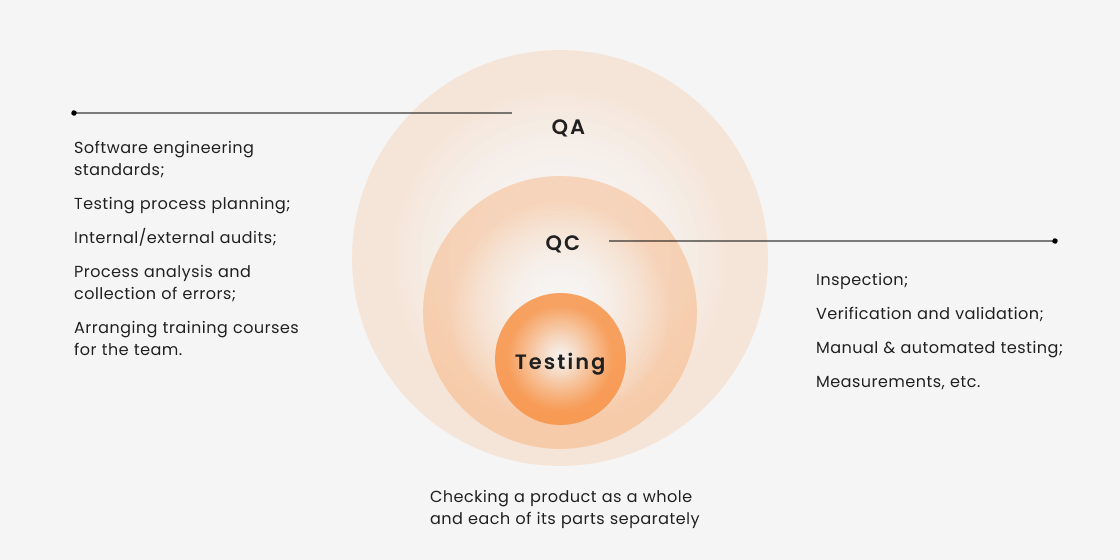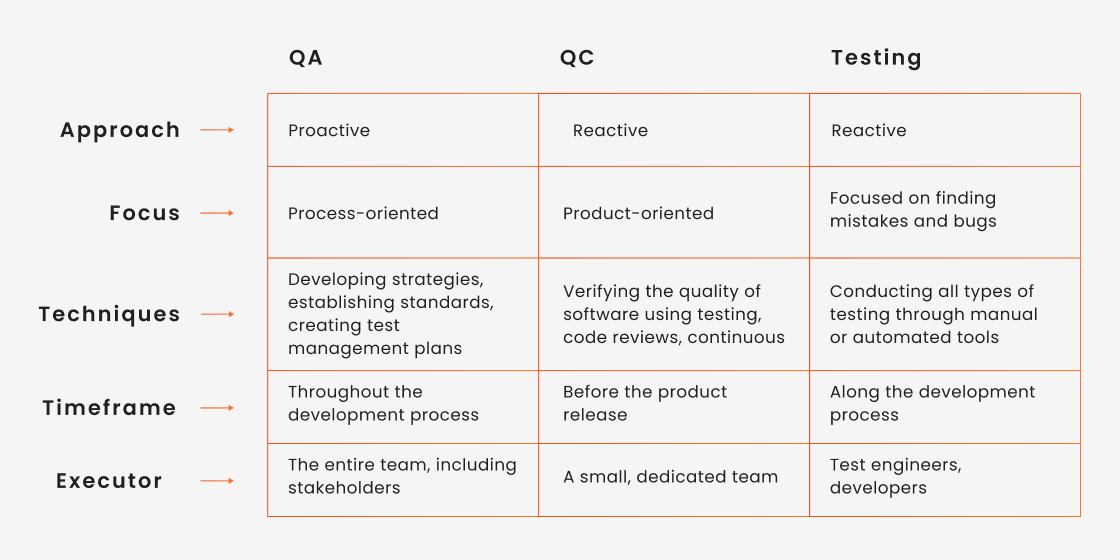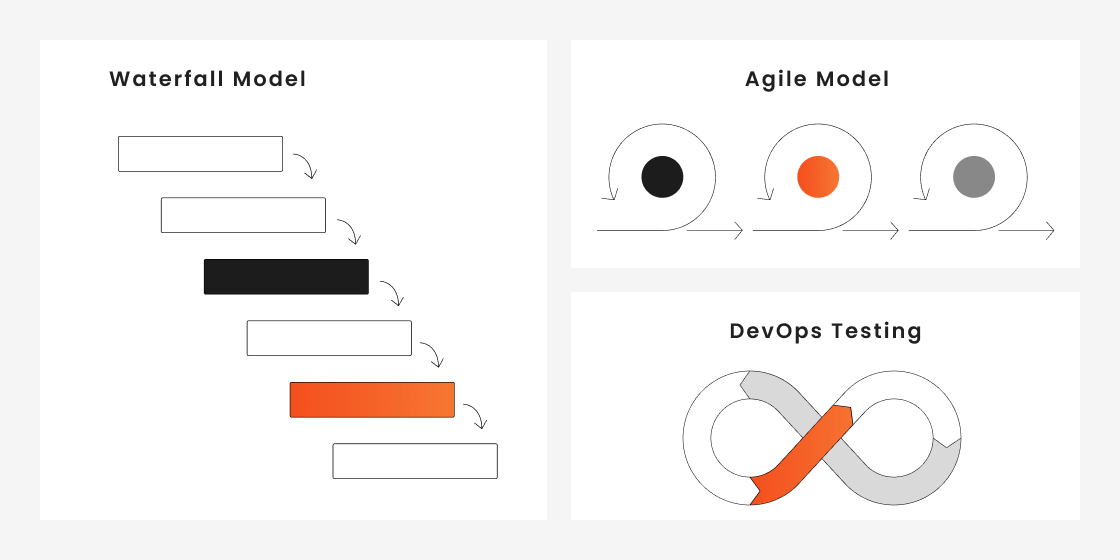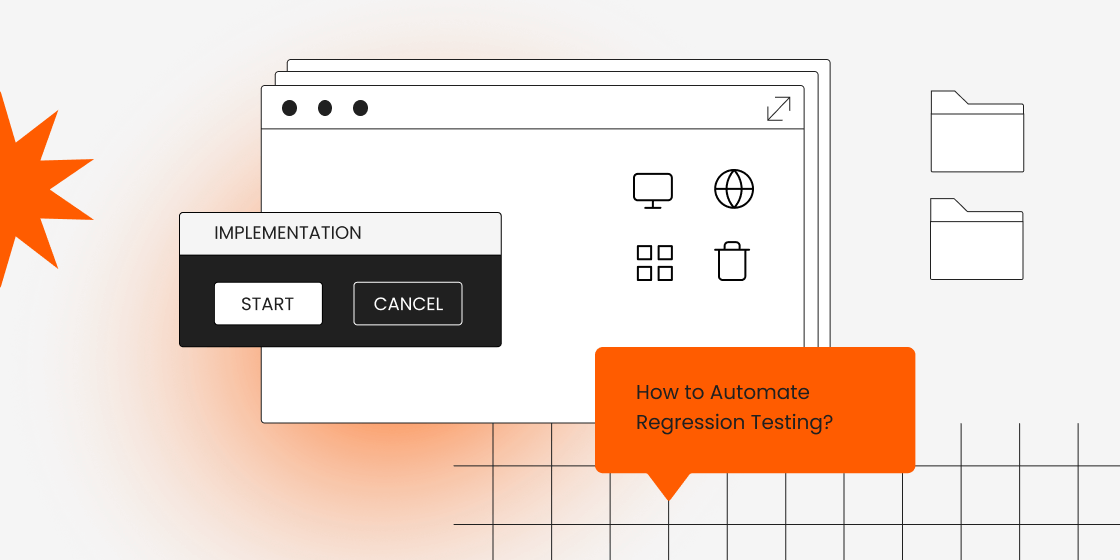Understanding Software QA, Quality Control, and Testing
Before we go any further, let’s start by clarifying what exactly software testing means because, while it seems all pretty simple, there’s quite a lot to it.
This concept was introduced as a means of accessing the conformance of software with implicit (things customers expect from a product based on their previous experiences) and explicit expectations (these are specific targets customers expect in terms of product quality and performance). Here are the two types of software testing conducted for this purpose:
- Functional, which focuses on the product’s functionality from the user’s point of view, e.g. its ease of use, convenience, UI design, absence of glitches, clear contact forms, price-to-quality ratio, and so on.
- Non-functional (or structural), performed to assess the inner components of the software, e.g. its code maintainability, scalability to handle increased loads, security measures, compatibility across different platforms and browsers, the list goes on.
Of course, assessing the quality of a product through structural testing without having expertise in this field isn’t easy. Therefore, structural quality testing is entrusted to experienced testers who possess a deep understanding of software architecture, coding principles, and system internals. Functional testing, on the other hand, is performed through software quality management activities, such as QA, QC, and testing.
Now, let’s look more closely at the aspects of functional testing. Quite often, when people talk about QA, QC, and testing, they mean the same thing. However, this isn’t entirely correct. Although all of these aspects are inherently aimed at delivering a high-quality product, they use different techniques (which we’ll cover later in the article).
What Is Software Quality Assurance?
Quality Assurance (QA) or Software Quality Assurance (SQA) is a term used to describe a systematic process of assessing the quality of software solutions and implementing ways to improve them. In a broader context, SQA refers to the organizational part of quality management when everyone on the team knows exactly in what order things need to be done and strictly adheres to these rules. This is the basis without which further testing is impossible.
Processes Involved
- Recognize and identify quality standards applicable in software development.
- Conduct regular quality reviews.
- Carry out processes for recording test data.
- Arrange and maintain documentation for QC measures.
Methods Used in QA
Let’s dive into the key QA methods that teams rely on to check their websites and applications for issues and bugs. In general, there are two types — non-functional and functional. Let’s start by quickly going through the phases of non-functional testing, which look like this:
- Vulnerability testing aims to detect any potential issues that could expose a website or application to security threats such as cyberattacks, data breaches, or unauthorized access.
- Compatibility testing is conducted to check the product’s compatibility with operating systems, browsers, hardware, and software to ensure that it functions correctly and consistently across different environments.
- Usability testing is executed to ensure that the product’s user interface is easy to understand and use so that end users can interact with a website or application intuitively and efficiently.
- Performance testing allows teams to ensure that the product’s performance remains consistent and flawless under various conditions, including high loads, low battery, and so on.
Now, it’s time to look more closely at functional testing methods. Here they are:
- Unit testing is used to test different parts and components of the software in isolation. Unit tests are written before building a module to test specific functions, classes, or modules in the codebase.
- Integration testing focuses on evaluating how different components or modules of the software interact with one another when integrated. It verifies that data flows smoothly between these integrated parts and that they work cohesively as a whole.
- System testing extends to the whole framework, enabling test engineers and developers to identify stability issues and spot bugs they haven’t noticed before.
- Acceptance testing is typically one of the final phases before the product’s release, which involves end-users and stakeholders to validate that the product meets requirements and expectations.
Advantages of Software QA
The advantages of implementing quality assurance in software development are numerous, including but not limited to the following aspects:
- Reduced risks of costly errors and rework. Since most errors are prevented early in software development, less time and resources are spent on major technical reviews in later stages.
- A high level of motivation. When everyone understands the product requirements and expectations, they are motivated to contribute their best efforts towards achieving a common goal.
- A culture of continuous improvement. With SQA requirements, teams rather collaborate with each other than supervise, which helps cultivate a culture of constant improvement and boosted productivity.
- Compliance with industry standards and regulations. Last but not least, software quality assurance testing helps ensure that products adhere to industry-specific standards and regulatory requirements. This is particularly important for niches such as healthcare, finance, and manufacturing, where non-compliance may lead to financial consequences.
Examples of QA
Here are some examples of QA activities:
- Project planning;
- Internal/external audits;
- Process analysis;
- Establishing standards;
- Arranging training courses for the team, and more.
What Is Quality Control?
QC refers to the meticulous examination of the software product to identify any deviations from established standards and specifications. It’s the process of monitoring and inspecting each phase of the SDLC to ensure that the final product meets the desired quality criteria. To put it in simpler terms, think of it as having a manager run quality checks on the website’s functionality by randomly testing its various components.
Processes Involved
- Monitor and inspect software at different stages of the SDLC.
- Take precautions to prevent bugs and errors in the initial stages of software development.
- Constantly analyze data to identify areas for improvement.
- Keep records of the actions taken to maintain accountability.
Methods Used in QC
There are two common methods used in software quality control testing — inspection and statistical quality control. Let’s talk about each in detail.
Starting with inspection, this approach falls into the following three categories:
- 100% product inspection and sample inspection.
- Process inspection.
- Inspection analysis.
Depending on the scale of a project, the product can be inspected either completely, which is usually done when the cost of defects is extremely high, or partially. In the latter case, companies typically choose a sample representative of the entire product lot and use sample results to decide if the product is good.
When it comes to statistical quality control, it focuses on three key aspects:
- Sampling plans and analysis, which allow organizations to measure the liquidity of the product by executing selective tests of product components
- Control charts.
- Corrective measures.
By checking samples of the final product along with control charts showing quality deviations from acceptable limits, teams can decide whether to move forward with product deployment or whether corrective action needs to be taken.
Advantages of QC
Below, we’ve briefly outlined the common benefits of implementing QC.
- Customer loyalty. Consistent delivery of high-quality software leads to building a loyal customer base
- Reduced costs. No bugs and errors means no additional costs to fix software solutions.
- Constant improvement. Tracking common error patterns helps avoid them in the future.
Examples of QC
- Inspection;
- Random samples control;
- Verification and validation;
- Manual & automated testing;
- Measurements, etc.
What Is Testing?
Testing is the process of checking a product as a whole and each of its parts separately. It can be carried out in many different ways using both manual approach and automated testing tools depending on the scale and goals of a project.
Processes Involved
- Develop a strategy outlining what aspects of the product will be tested, how testing will be conducted, and what criteria will define success.
- Create test cases that cover a wide range of functionalities of a product.
- Run test cases, either manually or through automated tools.
- Document any issues or deviations from expected behavior.
- Repeatedly test the software after each change or update to ensure that new modifications haven’t affected the product’s performance and functionality.
Differences Between SQA, SQC, and Testing
Now that we’ve looked at each of these concepts separately, let’s compare them side by side so you can better understand how they differ from each other.
1) Difference in Approach
The first difference is in the approach. While quality assurance is a proactive process, focused on preventing issues before the development process even begins, QC takes a more reactive stance by focusing on detecting issues after the product is developed. In regards to testing activities, they serve as a means by which the quality of the product itself is validated and ensured.
2) The Focus Is Different
QA is focused on procedures that need to take place to ensure the product quality, such as creating documentation, conducting audits, monitoring changes and updates, training staff, and so on. QC, on the other hand, is focused on the product. To find bugs and issues, teams use different types of testing, including software testing, batch inspection, validation, beta testing, etc. As you’ve guessed, testing is the method of checking the software for issues under the verification process.
3) Different Final Goal
The goal of software QA testing is to develop standard requirements for each step of the development cycle so that the final product falls in line with the established quality criteria. The goal of QC is to ensure that the product is vetted from bugs and is ready for release. And the purpose of testing is to create and execute test cases to help identify and fix potential issues.
4) Different Areas of Responsibility
Another distinct difference between these three aspects is who accomplishes the work. In the case of QA, the quality standards are set up through coordinated efforts of development, testing, and managerial teams and are met by each team member. QC, in turn, is the responsibility of a small dedicated team charged with inspecting and validating the product, while testing is usually carried out by a team of testers working in-house or remotely.
To make it a tad bit easier for you, we’ve put together a comparison chart that summarizes the key points.










